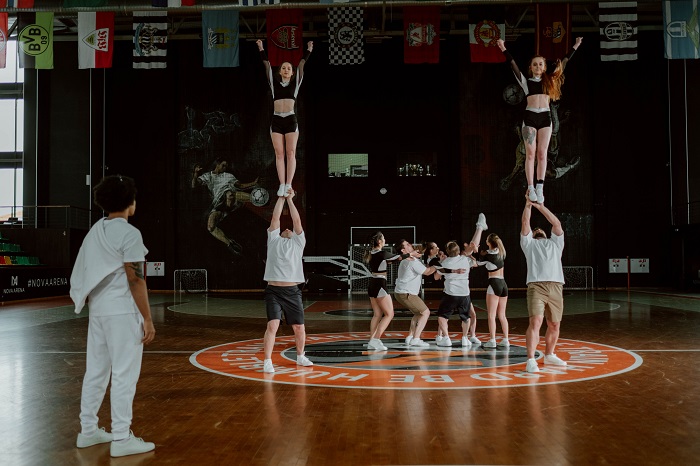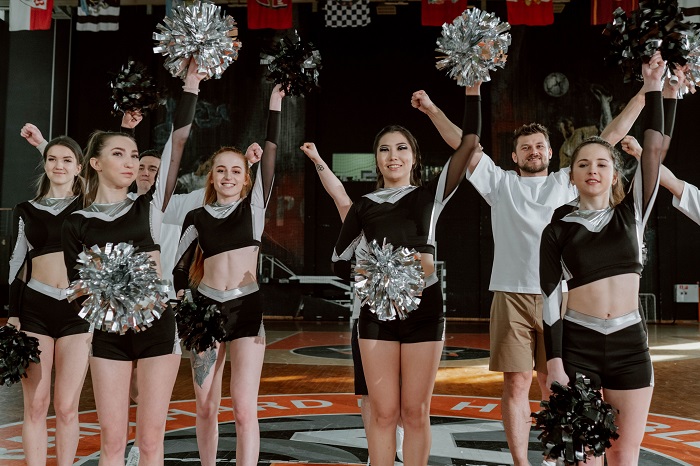
Gymnastics and Cheerleading Almost Indistinguishable
In the 1920’s women became active in cheerleading. The University of Minnesota cheerleaders began to incorporate gymnastics and tumbling into their cheers and in 1930’s universities and high schools began performing pom-pon routines and using paper pompons. Other important milestones include:
1950s: College cheerleaders began conducting cheerleading workshops to teach fundamental cheerleading skills.
1967: Marked the first annual ranking of the “Top Ten College Cheer Squads” and the initiation of the “Cheerleader All America” awards by the International Cheerleading Foundation.
1970s: In addition to cheering for the traditional football and basketball teams, cheerleaders began supporting all school sports, sometimes selecting several different squads to cheer for wrestling, track and swimming.
About Modern Cheerleading and Gymnastics
The modern cheerleader was forged in 1972 when she was waylaid by two distinct cultural forces. First was the passage of Title IX, which invigorated women’s sports programs at colleges and high schools. With more girls drifting toward soccer and volleyball, cheerleading seemed antiquated. Along came Jeff Webb, a former University of Oklahoma cheerleader, who turned his passion into a legitimate athletic pursuit by making it more like gymnastics. Through camps and workshops, Webb taught complicated flips and ditched the sweaters and long skirts for more aerodynamic uniforms. Cheerleading morphed from a purely social enterprise into part of a young woman’s athletic regimen: A 2002 survey showed that more than half of cheerleaders participated in other sports.
The first nation-wide television broadcast of the Collegiate Cheerleading Championships on CBS-TV in the Spring of 1978, initiated by the International Cheerleading Foundation.

Cheerleading began to receive recognition as a serious athletic activity as the skills level dramatically increased in areas such as gymnastics and cheerleading with partner stunts, pyramids, and advanced jumps. Many high school cheerleading squads began to cheer for female sports (basketball and volleyball) in addition to male sports. Training for cheerleading coaches was offered at summer cheerleading camps. Several colleges offered scholarships, college credits, and a four-year letter program. In the 1980s, national cheerleading competitions for junior and senior high school as well as collegiate squads took place across America. The I.C.F. Training Course for faculty cheerleading’sponsors’ and coaches was offered across the United States. Today, cheerleading enjoys the reputation of being an important leadership force on practically every high school and college campus in America. Competitions are held throughout the United States on local, state, and national levels.
The cheerleading competition trend has more streamlined rules .This year (2005-2006) the USASF and NACCC had merged forces and have released the new levels. If you’re a coach, make sure you study the levels. This will make you a much smarter coach when it comes time to start choreography and deciding which level to enter into. Another tip: Tip: Go to spring floor cheerleading competitions. Spring floors are safer and are much easier on your cheerleaders’ joints and muscles, particularly when combining gymnastics and cheerleading.
One final tip: When choosing cheerleading competitions look past gimmicks and sales pitches. Many cheerleading competition companies are now offering free admission to the general public. To offset this loss in revenue they increase the entry fee for each participant. Find out what is included in each cheerleader’s entry fee. Many cheerleading companies include event t-shirts and gifts with your entry fee.
In its 8th year of competition, cheerleading had nearly 420 athletes in the 2005 AAU Junior Olympic Games in New Orleans, LA. Competition was held in both team and individual divisions with the introduction of a Mini Novice and Advanced Divisions [2nd Grade & Under].
Some people object to the “sexiness” that is now part of cheerleading routines, according to an article by the Associated Press entitled “Cleaning up Cheerleading.”

” Bare midriffs. Short skirts. Bump-and-grind routines. Cheerleading has strayed far from the “2-4-6-8” routines of yesteryear, and that can leave parochial school cheerleading squads wondering how to craft routines that fit their values without looking downright retro. “
That’s where Christian cheerleading camps come in. A growing number of Christian schools, put off by the sometimes-seductive dances and cheers taught at secular camps, are opting instead for faith-based camps and competitions. It’s where Bible study meets basket tosses, and the music doesn’t have to be bleeped out. “
The Fellowship of Christian Cheerleaders, a Lawrenceville, GA company mixes religious messages with cheerleading. It has programs in which cheerleaders learn they don’t have to sacrifice modesty to have hip routines. It’s an approach that’s growing into big business for the two leading Christian cheerleading companies, FCC in Georgia and Christian Cheerleaders of America in Winston-Salem, N.C. FCC now works with 15,000 cheerleaders a year in faith-based camps and competitions, with a staff of 100 coaches. CCA teaches 7,000 cheerleaders a year and recently built a 27,000-square-foot gym. The camps work just like secular ones, but with devotional time added in mornings and nights. Most of the instructors are college cheerleaders who went to Christian schools. They tell campers that cheering is a God-given talent that can spread Christian lessons. Cheerleaders from Christian schools say they’ve felt left out at secular cheerleading camps, either because their skirts are too long or their coaches veto the music. At Christian camps, they all fit in.
Regardless of which approach one takes, as routines become more and more complex and rivalries grow, the gymnastic elements of cheerleading have become extremely important and demanding. That’s why so many cheerleaders and cheerleader want to bees are taking special gymnastic courses. It doesn’t take much to combine Training for cheerleading coaches was offered at summer cheerleading camps. Several colleges offered scholarships, college credits, and a four year letter program. In the 1980s national cheerleading competitions for junior and senior high school as well as collegiate squads took place across America. The I.C.F. Training Course for faculty cheerleading ‘sponsors’ and coaches was offered across the United States. Today cheerleading enjoys a reputation of being an important leadership force on practically every high school and college campus in America. Competitions are held throughout the United States on local, state and national levels.
The cheerleading competition trend has more streamlined rules .This year (2005-2006) the USASF and NACCC had merged forces and have released the new levels. If you’re a coach, make sure you study the levels. This will make you a much smarter coach when it comes time to start choreography and deciding which level to enter into. Another tip: Tip: Go to spring floor cheerleading competitions. Spring floors are safer and are much easier on your cheerleaders’ joints and muscles, particularly when combining gymnastics and cheerleading.

